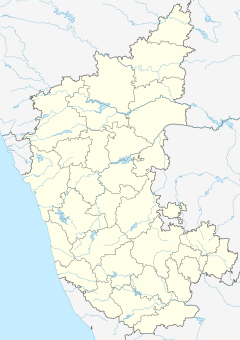Halasuru Someshwara Temple
| Halasuru Someshwara Temple | |
|---|---|

The entrance of Someshwara temple
|
|
| Name | |
| Kannada | ಹಲಸೂರು ಶ್ರೀ ಸೋಮೇಶ್ವರ ದೇವಸ್ಥಾನ |
| Geography | |
| Coordinates | 12°58′32″N 77°37′27″E / 12.975445°N 77.624231°ECoordinates: 12°58′32″N 77°37′27″E / 12.975445°N 77.624231°E |
| Country | India |
| State/province | Karnataka |
| District | Bangalore |
| Locale | Halasuru |
| Culture | |
| Primary deity | Someshwara |
Halasuru Someshwara Temple is located in the suburb of Halasuru (also called Ulsoor) in Bangalore, India. The oldest temple in the city dating back to the Chola period, it is dedicated to the Hindu god Shiva. Major additions or modifications were made during the late Vijayanagara Empire period under the rule of Hiriya Kempe Gowda II.
In the "Gazetter of Mysore" (1887), Benjamin Lewis Rice describes a legend behind the consecration of the temple. Kempe Gowda, while on a hunt, rode far away from his capital Yalahanka. Being tired, he rested under a tree and fell asleep. The local deity Someshwara appeared to him in a dream and instructed him to build a temple in his honor using buried treasure. In return the chieftain would receive divine favor. Kempe Gowda found the treasure and dutifully completed the temple. According to a different version of the legend, King Jayappa Gowda (1420-1450 CE) from a minor dynasty of the Yelahanka Nada Prabhus was hunting in a forest near the present Halasuru area, when he felt tired and relaxed under a tree. In a dream, a man appeared before him and told him that a linga (universal symbol of the god Shiva) was buried under the spot he was sleeping. He was instructed to retrieve it and build a temple. Jayappa found the treasure and initially built the temple out of wood. Another account attributes the temple to the Chola Dynasty with later renovations made by the Yelahanka Nada Prabhus.
According to Michell, the temple plan follows many of the basic elements of Vijayanagara architecture though at a lower scale. The temple has a square sanctum (garbhagriha) which is surrounded by a narrow passageway. The sanctum is connected to a closed mantapa (hall) whose walls are decorated with pilasters and sculptures in frieze. The closed mantapa is connected to a spacious open mantapa comsisting of four large projecting "bays" (area between four pillars). The piers leading to the sanctum and those facing outward from the open mantapa are the standard Yali (mythical beast) pillars. The eastern gopuram is a well executed, typical 16th century structure.
...
Wikipedia

